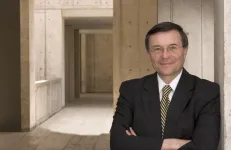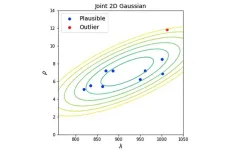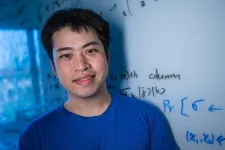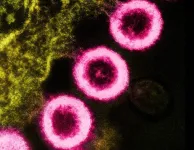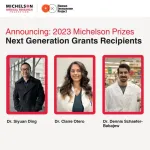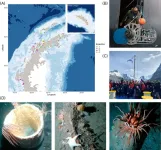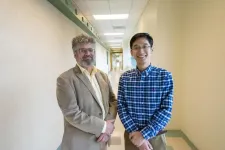(Press-News.org) LA JOLLA—(March 5, 2024) Salk Institute Professor Terrence Sejnowski will receive the 2024 Brain Prize for “pioneering the field of computational and theoretical neuroscience, making seminal contributions to our understanding of the brain, and paving the way for the development of brain-inspired artificial intelligence,” the Lundbeck Foundation announced today.
Sejnowski shares the prize—the world’s top recognition in neuroscience, totaling 10 million DKK (approximately $1.5 million)—with Larry Abbott of Columbia University and Haim Sompolinsky of Harvard University and Hebrew University. They will receive the award from His Royal Highness King Frederik of Denmark, at an event in Copenhagen on May 30, 2024.
“It is inconceivable to imagine modern brain sciences without the concomitant development of computational and theoretical neuroscience,” says Professor Richard Morris, chair of the Brain Prize Selection Committee. “These three scientists have applied novel and sophisticated approaches from physics, mathematics, and statistics to study the brain. They have developed vital tools for the analysis of highly complex datasets acquired by modern-day experimental neuroscientists.
“The three prize winners have also proposed conceptual frameworks for understanding some of the brain’s most fundamental processes, such as learning, memory, perception, and how the brain generates maps of the external world. They have also provided crucial new insights into what may go awry in several devastating disorders of the nervous system, such as epilepsy, Alzheimer’s disease, and schizophrenia. In addition, their scientific achievements have paved the way for the development of brain-inspired artificial intelligence, one of the emerging and transformational technologies of our time.”
Sejnowski, who is head of Salk’s Computational Neurobiology Laboratory, holder of the Francis Crick Chair, and a distinguished professor at UC San Diego, has helped shape the fields of neuroeconomics, neuroanatomy, neurophysiology, psychology, and artificial intelligence. In 1985, while at Johns Hopkins University, he collaborated with computer scientist Geoffrey Hinton to invent the Boltzmann machine, the first algorithm to solve the problem of learning in multilayered neural networks. It remains the most biologically plausible of all subsequent learning algorithms for artificial neural networks.
Soon after announcing the Boltzmann machine, Sejnowski created NETtalk, a computer program that, like the human brain, was able to learn how to turn written text into speech. Not only was this an astounding engineering accomplishment, but it also marked a major cultural milestone as it raised new challenges for philosophy, linguistics, and cognitive science.
Sejnowski also helped develop the first unsupervised learning algorithm for independent component analysis, which is now a mainstay in brain imaging. In addition, he has shown that sleep spindles (brain wave patterns during nonrapid eye movement sleep) are not synchronous across the cortex, as previously believed, but instead create circular traveling waves.
“Terry’s pioneering work in the field of neuroscience has long been recognized throughout the scientific community, and so this honor is not a complete surprise but is certainly an important accolade,” Salk President Gerald Joyce says. “His receiving the Brain Prize confirms how critical his work has been to our understanding of cognition and the world around us. We take special pride at Salk that two of our faculty have received this prize in the past three years, with Martyn Goulding having been honored in 2022.”
Sejnowski has received numerous other awards, including being named the 2024 Scientist of the Year by the ARCS Foundation of San Diego, winning the Gruber Prize in Neuroscience, the Institute of Electrical and Electronics Engineers Frank Rosenblatt Award, Neural Network Pioneer Award, Hebb Prize, and Wright Prize. He is a member of the National Academy of Sciences, National Academy of Medicine, National Academy of Engineering, and National Academy of Inventors.
“I am incredibly honored to receive the 2024 Brain Prize,” says Sejnowski. “I’m proud that this award recognizes the remarkable computational advances being made by computer scientists and neuroscientists to our understanding of brain function.”
About the Brain Prize:
The Brain Prize is the world’s largest neuroscience research prize, and it is awarded each year by the Lundbeck Foundation. The Brain Prize recognizes highly original and influential advances in any area of brain research, from basic neuroscience to applied clinical research. Recipients of The Brain Prize may be of any nationality and work in any country in the world. Since it was first awarded in 2011, The Brain Prize has been awarded to 47 scientists from 10 different countries. Brain Prize recipients are presented with their award by His Royal Highness King Frederik of Denmark, at a ceremony in the Danish capital, Copenhagen.
About the Salk Institute for Biological Studies:
Unlocking the secrets of life itself is the driving force behind the Salk Institute. Our team of world-class, award-winning scientists pushes the boundaries of knowledge in areas such as neuroscience, cancer research, aging, immunobiology, plant biology, computational biology, and more. Founded by Jonas Salk, developer of the first safe and effective polio vaccine, the Institute is an independent, nonprofit research organization and architectural landmark: small by choice, intimate by nature, and fearless in the face of any challenge. Learn more at www.salk.edu.
END
Salk Professor Terrence Sejnowski wins Brain Prize
World’s largest neuroscience prize recognizes trio who pioneered field of computational and theoretical neuroscience and paved the way for brain-inspired artificial intelligence
2024-03-05
ELSE PRESS RELEASES FROM THIS DATE:
A call for standardization of controls in lifespan studies
2024-03-05
“[...] we posit that the majority of results in biology of aging may be irrelevant to the fundamental aim of this field and must be acknowledged appropriately.”
BUFFALO, NY- March 5, 2024 – A new research perspective was published in Aging (listed by MEDLINE/PubMed as "Aging (Albany NY)" and "Aging-US" by Web of Science) Volume 16, Issue 4, entitled, “On standardization of controls in lifespan studies.”
In this new paper, researchers Olga Spiridonova, Dmitrii Kriukov, Nikolai Nemirovich-Danchenko, and Leonid Peshkin from Harvard Medical ...
How bias shows up in maps made with citizen science data
2024-03-05
When biologist Elizabeth Carlen pulled up in her 2007 Subaru for her first look around St. Louis, she was already checking for the squirrels. Arriving as a newcomer from New York City, Carlen had scrolled through maps and lists of recent sightings in a digital application called iNaturalist. This app is a popular tool for reporting and sharing sightings of animals and plants.
People often start using apps like iNaturalist and eBird when they get interested in a contributory science project (also sometimes called a citizen science project). Armed with cellphones equipped with cameras and GPS, app-wielding volunteers can submit geolocated data that iNaturalist then translates into user-friendly ...
Rice’s Nai-Hui Chia wins NSF CAREER Award
2024-03-05
HOUSTON – (March 5, 2024) – Nai-Hui Chia, an assistant professor of computer science at Rice University, has won a National Science Foundation CAREER Award to develop a new theoretical framework to facilitate the development of efficient quantum algorithms for a range of problems in quantum physics and computer science as well as enhance the security of quantum cryptography.
The highly competitive grants are awarded each year to a selective cohort of about 500 early career faculty across all disciplines engaged in pathbreaking research and committed to growing their field through outreach and education.
“Quantum computing holds immense ...
Vaginal ring and oral pre-exposure prophylaxis found safe for HIV prevention throughout pregnancy
2024-03-05
WHAT:
The monthly dapivirine vaginal ring and daily oral pre-exposure prophylaxis (PrEP) with tenofovir disoproxil fumarate and emtricitabine were each found to be safe for HIV prevention among cisgender women who started using one of them in their second trimester of pregnancy, according to findings presented today at the 2024 Conference on Retroviruses and Opportunistic Infections (CROI) in Denver. Pregnant people are estimated to be three times more likely to acquire HIV through sexual intercourse than similarly aged people who ...
Michelson Medical Research Foundation and Human Immunome Project announce 2023 Michelson Prize Laureates
2024-03-05
Michelson Medical Research Foundation (MMRF) and Human Immunome Project (HIP) have awarded Dr. Siyuan Ding (Washington University in St. Louis), Dr. Claire Otero (Weill Cornell Medicine), and Dr. Dennis Schaefer-Babajew (Rockefeller University) the Michelson Prizes: Next Generation Grants, the organizations announced today.
The $150,000 research grants are awarded annually to support early-career scientists advancing human immunology, vaccine discovery, and immunotherapy research for major global ...
New method measures the 3D position of individual atoms
2024-03-05
Since more than a decade it has been possible for physicists to accurately measure the location of individual atoms to a precision of smaller than one thousandth of a millimeter using a special type of microscope. However, this method has so far only provided the x and y coordinates. Information on the vertical position of the atom – i.e., the distance between the atom and the microscope objective – is lacking. A new method has now been developed that can determine all three spatial coordinates of an atom with one single image. This method – developed by the University of Bonn and University of Bristol ...
Cleveland Clinic-led research supports repurposing sildenafil (Viagra) for Alzheimer’s treatment
2024-03-05
CLEVELAND – New Cleveland Clinic-led research points to sildenafil (Viagra) as a potential treatment for Alzheimer’s disease. The study provides evidence from computational models, insurance claims data and observations from brain cells in Alzheimer’s patients.
Sildenafil is the main component of drugs used to treat erectile dysfunction (Viagra) and pulmonary arterial hypertension (Revatio).
“Our findings provide further weight to re-purposing this existing FDA-approved drug as a novel treatment for Alzheimer’s, which is in great need of new therapies,” ...
Antarctic researchers hitched a lift on a cruise ship, and recommend this eco-friendly, collaborative approach to remote ocean science
2024-03-05
Antarctic researchers hitched a lift on a cruise ship, and recommend this eco-friendly, collaborative approach to remote ocean science.
####
Article URL: https://journals.plos.org/climate/article?id=10.1371/journal.pclm.0000348
Article Title: New methods of undertaking marine science in Antarctica using tourism vessels
Contact: Matthew Mulrennan; matt@kolossal.org
Author Countries: Canada, United States
Funding: The authors received no specific funding for this work. END ...
Odysseus has a new home and brings the Earthling Project along for the ride
2024-03-05
March 5, 2024, Mountain View, CA – The moon lander Odysseus, known as Odie, touched down on the Moon's surface on February 22, becoming the first time the U.S. has landed on the Moon in more than 50 years and the first commercial moon lander to successfully land on the Moon. Along with its science payload, the spacecraft also brought along a fusion of art and space exploration, SETI Institute's Artist in Residence (SETI AIR), Felipe Pérez Santiago's Earthling Project, a collection of global musical compositions representing Earth's cultural ...
Painting a molecular portrait of the brain with mass spectrometry and deep learning
2024-03-05
Beckman Institute for Advanced Science and Technology researchers Jonathan Sweedler, a professor of chemistry, and Fan Lam, a professor of bioengineering, outlined how spatial omics technologies can reveal the molecular intricacy of the brain at different scales.
Their research appeared this month in Nature Methods.
The researchers and their colleagues used a biochemical imaging framework integrated with deep learning to create 3D molecular maps with cell specificity to better understand how the brain functions in health and disease. Their research is supported by a $3 million grant from ...
LAST 30 PRESS RELEASES:
Mount Sinai Health system receives $8.5 million NIH grant renewal to advance research on long-term outcomes in children with congenital heart disease
Researchers develop treatment for advanced prostate cancer that could eliminate severe side effects
Keck Medicine of USC names Christian Pass chief financial officer
Inflatable fabric robotic arm picks apples
MD Anderson and SOPHiA GENETICS announce strategic collaboration to accelerate AI-driven precision oncology
Oil residues can travel over 5,000 miles on ocean debris, study finds
Korea University researchers discover that cholesterol-lowering drug can overcome chemotherapy resistance in triple-negative breast cancer
Ushikuvirus: A newly discovered giant virus may offer clues to the origin of life
Boosting the cell’s own cleanup
Movement matters: Light activity led to better survival in diabetes, heart, kidney disease
Method developed to identify best treatment combinations for glioblastoma based on unique cellular targets
Self-guided behavioral app helps children with epilepsy sleep earlier
Higher consumption of food preservatives is associated with an increased risk of type 2 diabetes
NTU Singapore-led team captures first-ever ‘twitch’ of the eye’s night-vision cells as they detect light, paving the way for earlier detection of blindness-causing diseases
Global aviation emissions could be halved through maximising efficiency gains, new study shows
Fewer layovers, better-connected airports, more firm growth
Exposure to natural light improves metabolic health
As we age, immune cells protect the spinal cord
New expert guidance urges caution before surgery for patients with treatment-resistant constipation
Solar hydrogen can now be produced efficiently without the scarce metal platinum
Sleeping in on weekends may help boost teens’ mental health
Study: Teens use cellphones for an hour a day at school
After more than two years of war, Palestinian children are hungry, denied education and “like the living dead”
The untold story of life with Prader-Willi syndrome - according to the siblings who live it
How the parasite that ‘gave up sex’ found more hosts – and why its victory won’t last
When is it time to jump? The boiling frog problem of AI use in physics education
Twitter data reveals partisan divide in understanding why pollen season's getting worse
AI is quick but risky for updating old software
Revolutionizing biosecurity: new multi-omics framework to transform invasive species management
From ancient herb to modern medicine: new review unveils the multi-targeted healing potential of Borago officinalis
[Press-News.org] Salk Professor Terrence Sejnowski wins Brain PrizeWorld’s largest neuroscience prize recognizes trio who pioneered field of computational and theoretical neuroscience and paved the way for brain-inspired artificial intelligence
